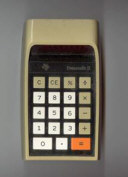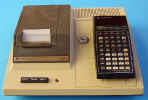
DATAMATH CALCULATOR MUSEUM
 |
DATAMATH CALCULATOR MUSEUM |
 Dallas
(May 24, 1977) „New Programmable Calculators from Texas Instruments
feature Solid State Software Program Libraries. In order to encourage interest
in programming and computational problem solving, Texas Instruments introduced a
number of new general purpose and specialty calculators...TI Programmable 57 (
with 30,000 transistors -- most powerful single chip calculator ever produced),
and the TI Programmable 58 and 59.“
Dallas
(May 24, 1977) „New Programmable Calculators from Texas Instruments
feature Solid State Software Program Libraries. In order to encourage interest
in programming and computational problem solving, Texas Instruments introduced a
number of new general purpose and specialty calculators...TI Programmable 57 (
with 30,000 transistors -- most powerful single chip calculator ever produced),
and the TI Programmable 58 and 59.“
Today - 30 years later - we remember this press release from Texas Instruments and place some milestones around the year 1977 in steps of 5 years:
| • 1967: Texas Instruments invented the
Integrated Circuit • 1972: Texas Instruments started the calculator business with the formal introduction of the TI-2500 Datamath • 1977: Texas Instruments introduced with the TI-59 and its smaller sibling TI-58 the most versatile calculators of that time • 1982: A dark year, Texas instruments cancelled the TI-88 project • 1987: The powerful TI-95 PROCALC arrived • 1992: Texas Instruments leads the upper end of the calculator market with a full line of graphics calculators like the TI-81 and TI-85 • 1997: The TI-92 introduced Symbolic calculating on handheld devices • 2002: Texas Instruments sampled with the PLT-SHH1 a unique graphing calculator based on a PDA (Personal Digital Assistant). • 2007: Starting with the TI-81 sales of Texas Instruments have accumulated to more than 40 million graphing calculators. And we are still waiting for the TI-Nspire™ and TI-Nspire™ CAS. |
 The TI-59 calculator is difficult to describe. In the year
1977 it marked the top of the programmable handheld-calculators with up to 960
programming steps or 100 user memories, a magnetic card reader, the novel Solid
State Software Modules™ and the PC100A alphanumeric printer. On the other hand
it was the last development using the powerful and modular TMC0501 calculator
architecture. Nowadays it is very difficult to explain an early calculator
architecture because all „transistor-count“ limitations were past. But
remember Moore’s Law published already in the year 1965 at the beginning of
the Integrated Circuits (IC’s) era: Moore predicted that the number of
transistors per Integrated Circuit would double every 18 months. He forecast
that this trend would continue through 1975. Today we know, Moore's Law has been
maintained for far longer, and still holds with a doubling every 12 to 36 month
true as we entered the new century.
The TI-59 calculator is difficult to describe. In the year
1977 it marked the top of the programmable handheld-calculators with up to 960
programming steps or 100 user memories, a magnetic card reader, the novel Solid
State Software Modules™ and the PC100A alphanumeric printer. On the other hand
it was the last development using the powerful and modular TMC0501 calculator
architecture. Nowadays it is very difficult to explain an early calculator
architecture because all „transistor-count“ limitations were past. But
remember Moore’s Law published already in the year 1965 at the beginning of
the Integrated Circuits (IC’s) era: Moore predicted that the number of
transistors per Integrated Circuit would double every 18 months. He forecast
that this trend would continue through 1975. Today we know, Moore's Law has been
maintained for far longer, and still holds with a doubling every 12 to 36 month
true as we entered the new century.
 Simple calculators like the Canon Pocketronic introduced in
the year 1970 used three IC’s sporting about 1000 transistors each. The first
single-chip calculator circuit TMS1802 integrated the complexity of roughly 5000
transistors in the year 1972 but still featured only four functions. The market
asked for higher sophisticated calculators with logarithm, trigonometric
functions, user memories and even programmability. But the technology wasn’t
available that time to integrate all functions into one circuit. Texas
Instruments followed in these early days two different approaches:
Simple calculators like the Canon Pocketronic introduced in
the year 1970 used three IC’s sporting about 1000 transistors each. The first
single-chip calculator circuit TMS1802 integrated the complexity of roughly 5000
transistors in the year 1972 but still featured only four functions. The market
asked for higher sophisticated calculators with logarithm, trigonometric
functions, user memories and even programmability. But the technology wasn’t
available that time to integrate all functions into one circuit. Texas
Instruments followed in these early days two different approaches:
|
• The single-chip calculator technology was streamlined to a
more universal approach leading to the well known
TMS1000 microcomputer
family |
If we discover current electronic handheld calculators we still find two different architectures:
| • Single-chip calculators based on a modern microcomputer
family, usually Toshiba products. • Microprocessor architectures with external ROM (read only memory), RAM (program and data memory) and display drivers centered around an 8-bit Z80 microprocessor (TI-81) or a 32-bit MC68000 microprocessor (TI-92). |
The next tables describe the calculators leading to the TMC0501 architecture, the calculators using the TMC0501 circuit and some products following the TI-59 calculator.
Picture |
Introduction |
Name |
Comments |
 |
Sept. 1972 | TI-2500 | The TI-2500 Datamath calculator used with the TMS0119 a derivate of the original TMS1802 "calculator-on-a-chip". |
 |
Nov. 1972 | SR-10 |
With the TMS0120 used in the SR-10 engineers in Dallas added to the 8 digit mantissa a two digit exponent display and created the first scientific calculator. Just to recall, the calculator was named Electronic Slide Rule. |
Picture |
Introduction |
Name |
Comments |
 |
Jan. 1974 | SR-50 | The SR-50 started the era of the TMC0501 based calculators. Using one additional TMC0521 SCOM (scanning read only memory) to the Arithmetic circuit the SR-50 could be called the first „full“ scientific calculator. |
 |
Jan. 1975 | SR-51 |
With the SR-51 Texas Instruments made the first time use of the expandability of the TMC0501 architecture. With two SCOM circuits (TMC0522, 0523) the SR-50 got additional statistical functions plus some conversion constants. |
 |
Mar. 1975 | SR-50A | The SR-50A put the SR-50 electronics in a simpler housing to reduce manufacturing costs. |
 |
Jun. 1975 | SR-51A |
The SR-51A put the SR-51 electronics in a simpler housing to reduce manufacturing costs. |
 |
Sep. 1975 | SR-52 |
The remarkable SR-52 is the direct predecessor of the TI-59 and uses most features of the TMC0501 architecture. A deeper exploration of the calculator shows a TMC0501 Arithmetic chip surrounded with a TMC0524 SCOM, two TMC0561/0562 BROM (bare ROM like a SCOM without the scanning feature necessary for the keyboard), two TMC0599 RAM chips for program and data and finally a TMC0595 controlling the internal magnet card read/writer |
 |
May 1976 | SR-56 | The SR-56 used again the flexibility of the TMC0501 building blocks and added with the TMC0599 a RAM chip to create a programmable scientific calculator. Under the chargeable battery pack a connector brought some internal signals to the outside world and allowed the use of a PC100 printer/security cradle. Otherwise it looks similar to the SR-50A using the TMS0537/0538 SCOM circuits. |
 |
May 24,1977 | TI-59 | The TI-59 eventually put all together ! Supplementary to the architecture found in the SR-52 a second ROM in a removable plastic housing called Solid State Software Module™ was added. While the SCOM and BROM memories store the firmware of the calculator, e.g. the algorithm to calculate the log of a number these modules contain application programs with an overall amount of 5000 steps. Each calculator included one module called Master Library with 25 programs. Beside the 13 Solid State Software Modules available from Texas Instruments a lot of highly specialized modules appeared from third party companies. |
 |
May 24,1977 | TI-58 |
The TI-58 introduced together with the TI-59 removed the magnetic card reader and cut the RAM size in half leading to a maximum of 480 program steps or 60 user memories. At first glance a negligible change because the calculator lost the program like the bigger sibling but you had to type it in hand-operated instead using the card reader! Nevertheless the TI-58 was a big success. Dozens of companies developed Solid State Software Modules™ for the TI-58 and even changed the keyboard to customize the calculator for an application. Get some examples in the last line. |
 |
1978 | TI-58 Marine Navigation |
The TI-58 Marine Navigation combined the TI-58, the "Marine Navigation" Solid State Software Module™ and a DC power supply in a solid wooden box for usage on a boat. |
 |
1979 | TI-58C | The TI-58C changed the architecture of the original TI-58 slightly. Removing the old-fashioned TMC0598 RAM’s found in both the TI-58 and TI-59 it introduced a low-power C-MOS RAM connected permanently to the power supply. This resulted in a „Continuous Memory“, even in the off-state the user program and data was stored in the calculator. The TI-58C and TI-59 were produced at least until the year 1983 and gave the TMC0501 architecture a life time of 10 years! |
 

 
       |
|||
Picture |
Introduction |
Name |
Comments |
 |
never (1982) |
TI-88 | The TI-88 was supposed to succeed the TI-59. It was announced early in the year 1982 and attracted many TI-58C/59 owners with its alphanumeric display, thousands of program steps, two interchangeable software modules, printer interface and advanced symbolic language. Unfortunately and without any comment the calculator project was cancelled autumn 1982. Maybe Hewlett Packard's advanced HP41C killed the project. The hardware architecture of the calculator is very interesting and uses a total of three 4-bit single-chip microcontrollers based on the TMS1000 family. |
 |
1983 | TI-66 |
The TI-66 looks different to the known calculators from Texas Instruments and it is. Today we know that this calculator was designed from first scratch and manufactured by Japanese Toshiba company. Nevertheless the calculator could be called the successor of the TI-58C. The calculator is based on a Toshiba single-chip microcontroller. |
 |
1987 | TI-95 | Another remarkable calculator was introduced with the TI-95 PROCALC. A huge alphanumeric display, standard keyboard, 8K of RAM and a symbolic programming language based on the TI-59 dialect together with interchangeable software cartridges were surrounded with peripheral products like the PC-324 printer. Anyway the calculator failed on the market. The architecture was centered around an 8-bit TMC7000 microcontroller. |
| 1990 | TI-81 | The TI-81 was introduced 13 years after the TI-59 and was the last hope for the advanced calculator line of Texas Instruments. And it worked! They entered the market of Graphics calculators and again proofed true to lead the market. In the year 2000 Texas Instruments sold millions and millions of the TI-83 Plus. The hardware of the TI-81 is similar to a lot of other products: A 8-bit microprocessor of the Z80 family, a huge ROM of 128k Byte capacity, a RAM of 8k Byte size and a drivers for the LCD display. |
|
 |
Jan. 1996 | TI-92 | With the TI-92 Texas Instruments introduced the first Symbolic calculator. From the appearance similar to the TI-95 it outdated competition with the power of a 32-bit MC68000 microprocessor and a perfect user-interface providing even 3-dimensional graphs on a high resolution display. |
 |
1998 | TI-89 | The TI-89 proofed the genius of Texas Instruments calculator development true. The power of the TI-92 with the size of a handheld electronic calculator! |
 |
never (2002) |
PLT-SHH1 | Unfortunately we don't know too much about this unique graphing calculator based on a PDA (Personal Digital Assistant). |
Texas Instruments
published all details of the TI-59 calculator architecture: The patent
application US3900722 describes the TMC0501 and the SCOM, US4208720 the
SR-56, US 4107782 the SR-60 and US4153937 the TI-59. Fortunately some TI-59 fans
combined the schematics of the TI-59 Service Manual with the information
discovered in the patent applications.
Sipke
de Wal compiled a perfect block diagram of
both the calculator itself and the
CPU (central processing unit) with all the
RAM and ROM chips. On his site you could download all the diagrams of the TI-59.
Dejan
Ristanovic maintains a wonderful and informative site featuring the TI-59 and nothing else.
Christopher Westfall tells you all about your First Steps of TI-59
Programming.
Sipke de Wal put the Schematics of
the TI-59 on the web.
One important calculator is missing, the huge programmable desktop calculator SR-60 and its successor SR-60A. Unfortunately we own only the SR-60A and don’t have access to a SR-60. To finish the story I need the TMC05xx designations of all chips inside a SR-60. Dear fellow collector, if you are the happy owner of a SR-60 please do me a favor and contact me via email: joerg@datamath.org
If you have additions to the above article please email: joerg@datamath.org.
© Joerg Woerner, April 14, 2002. No reprints without written permission.